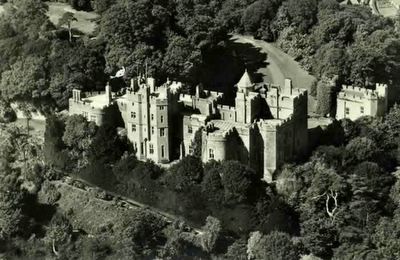
In later years Dunster Castle became less blurry, but in the process was reduced to black-and-white.
Into the 1400s the area of Exmoor was only sparsely populated, but at least one family made its home there: the Slocombes. They may or may not initially have been residents of Dunster, but they are most closely associated with an area on the other side (near side in the photo, I believe) of Dunster Castle: Slo Combe itself, from which the family derived its name. I would not be against the use of derove either, but ablaut is rare among English words of Latin origin.
Sloe are wild plum trees; they thrived (or throve)—still thrive, in fact—on the Combe, and it is comforting to know that one’s name comes from a toothsome fruit of the Rosaceae family. Remnants of a vineyard can still be seen on the Combe, which has also been a site for the raising of sheep. No trace of any artificial structure can be found, however, and it is likely that the Slocombe family lived very near the Combe and used it for commercial purposes. Some of the oldest records regarding the Slocombes show ownership of land near Dunster Castle.
The earliest known record of a Slocombe is in a document from a legal proceeding in 1308 at Dunster Castle itself, which tells of one John de Slocombe who testified in the case. I hope he did not bear false witness. Either way we can eagerly anticipate celebrating the 700th anniversary of his testimony in a few short years.
Source: The Slocum Family Project, http://www.slocombe.freeservers.com/index.html
No comments:
Post a Comment